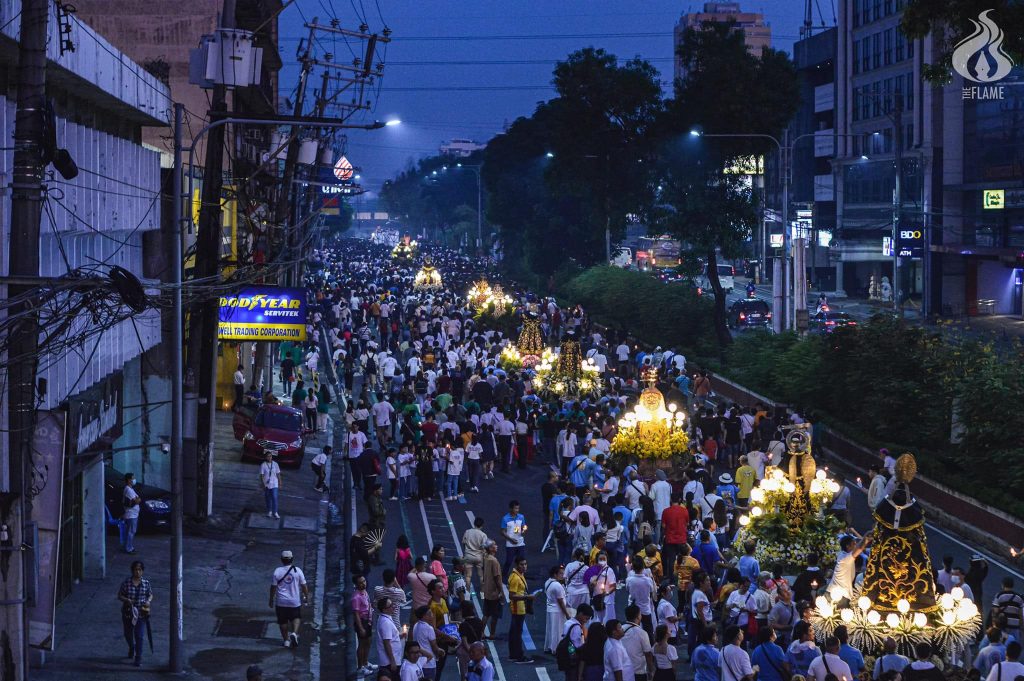
The feast of Our Lady of La Naval in Quezon City, one of the most anticipated religious events in predominantly Catholic Philippines, is expected to draw more devotees this year, organizers said.
“According to the Traffic and Transport Management Development, an estimate of 200,000 people is the projected crowd on the exact day of the fiesta,” Br. Nico Paolo Moron, O.P. told The Flame.
Nearly 100,000 people participated in last year’s grand procession.
The statue of Our Lady of Naval, the first canonically crowned Marian image in the country and in Asia, is venerated at the Santo Domingo Church in Quezon City. The image, which depicts the Blessed Virgin Mary in regal vestments and holding the infant Jesus and a rosary, is honored with a grand procession every second Sunday of October.
This year’s feast will coincide with the 85th anniversary of the foundation of Quezon City and will carry the theme “Mary: Advocate of Heavenly Favors.”
The theme honors the 51st anniversary of Pope Paul VI’s proclamation of Our Lady of La Naval as the city’s patroness.
The festivities will begin on Oct. 3 with the traditional enthronement rites, which will be followed by novena masses from Oct. 4 to 12. The grand procession featuring the image of Our Lady of La Naval, St. Joseph and more than 20 Dominican saints will be held on Oct. 13.
A member of the La Naval organizing committee who requested anonymity said this year’s theme drew inspiration from the devotees’ appreciation of the Blessed Virgin Mary who demonstrated obedience and love for her child Jesus. The faith and prayers of devotees would make the celebration “unique” even if the rituals are done annually, he added.
“I think the faith that the people [have] in everything that we do is always different every day in every festivity. So the fiesta is the same because this is kind of an annual thing but the faith that they have would be different,” the organizing committee member said.
He noted that the feast has been ingrained in the Filipino tradition as a predominantly Catholic.
“I would always say ‘No mother rejects her child,’ with the same idea, ‘There is no child who says no to his mother.’ So, the Blessed Virgin Mary being our mother, that’s our way of endearment to her. That’s our way of showing our faith to her as the Mother of God and our Mother,” he said.
“I would always say that the feast of Our Lady of La Naval is always part of the people’s tradition because this is as old as time. First, it’s part of their Catholic journey towards faith. Second, it’s because this is our way of expressing our love to the Blessed Mother.”
La Naval devotee Ted Tuvera said the devotion to the Virgin Mary is not just about seeking miracles and thanking her for the blessings obtained through her intercession.
“I think joining the procession is an expression of affection to the Blessed Mother. I am sure my fellow La Naval devotees would agree with me that our dear Mother brings about an unexplainable effect on us and possesses a different aura,” Tuvera said in Filipino.
“Yes, when you look at it, it is just an image. But it gives me an assurance that there is a Mother who loves me.”
The feast of Our Lady of La Naval commemorates the triumph of the outnumbered Spanish-Filipino troops against the Protestant Dutch naval forces that failed to conquer the Philippines five times in the 17th century. The victories were attributed to the intercession of Our Lady of the Holy Rosary.
The image and its shrine were named National Cultural Treasures of the Philippines in 2009.
The Santo Domingo Church began housing the image in 1952 after its original home in Intramuros was destroyed during World War II.
Last year, devotees celebrated the 50th anniversary of Our Lady of La Naval as the patroness of Quezon City. F — reports by Rachelle Anne Mirasol and Ma. Alyanna Selda



